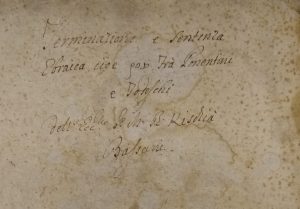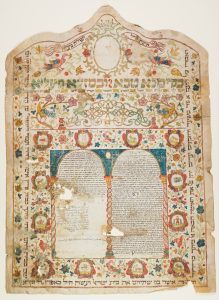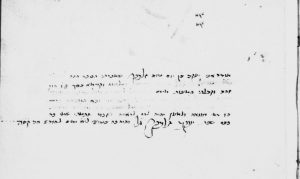This essay was initially published in the Institute for Israel and Jewish Studies‘ Spring 2021 newsletter. It is copied here with permission.

Salo Baron’s impact on Jewish Studies in America is widely known. Less well known, however, is the impact he made in building the Judaica collection at Columbia University. Soon after Baron’s arrival at Columbia, and long before he became known as the founder of Jewish historical studies in the United States, Baron became active in building his home institution’s world class Judaica collections. In the annual Report of the Librarian for 1933, Baron’s goal for Columbia’s collection was cited as “a double one: to increase the existing Hebrew collections so as to accumulate a good working library for research students, and to develop…the Library…through the acquisition of manuscripts and rare prints.” (Librarian’s report, 1933, p.17) He would be very successful in these endeavors — the library’s annual reports and internal memoranda regularly show acquisitions funded by Baron’s endowment or acquired with his recommendation.
In the early 1930s, Baron was in contact with the Viennese bookdealer, David Fraenkel, regarding an extensive collection of manuscripts available for purchase. The collection was broken down to 18 categories, including “Bible, Books of Cabbala, [sic]. Documents of communities and Jewish history, Jewish law, Karaite Literature, and marriage documents,” for approximately 650 manuscripts. After discussion with and approval by the library, Baron acquired the collection for Columbia with funds from the same endowment that had established his Chair in Jewish Studies in 1930.
As soon as the collection arrived, Baron dove right into the manuscripts. By 1937, he had written and published his first article using a manuscript from the new collection (Columbia MS X893.19 B29). Printed in Hebrew in a festschrift (a commemorative volume) honoring Professor Samuel Krauss (a professor at the Jewish Theological Seminary at Vienna), the article was about a dispute that took place in Verona between the Sephardic and Ashkenazic congregations there. The disagreement began when the Sephardic community opened a new synagogue in 1653, even though the community had agreed not to open a new synagogue there some twenty years earlier. Baron’s first footnote on the article reveals some of his excitement in being able to cite the new Columbia manuscript (my translation from the Hebrew): “from the collection of manuscripts that were acquired from Rabbi David Fraenkel in the year 1932.” It was not general practice to indicate acquisition information when citing primary sources, but clearly Baron was very pleased about this very new collection – as well he should have been!

Baron also wrote extensively on the Jews of Greece, focusing on the significant collection of Greek Jewish material in the Fraenkel archive. Baron certainly recognized the uniqueness and importance of these manuscripts, which documented a community that had not been studied very much (if at all) at that point. Baron published a series of articles describing various aspects of Greek Jewish life, especially in Corfu. He published a piece in 1942 on pidyon shevuyin, the purchase (and thus redemption) of Jewish captives by the Jews of Corfu. The same article, using a pinkas (community record book) from the archive, discussed varied communal activities of the Jews in that city (Columbia MS X893.19 P653). Additional articles focused on the communal disputes between the dwindling native Greek Jewish population and the Italian emigre community in Corfu (Columbia MSS X893 Z8 vol. 3 no. 6 and X893.19 D35).
Baron also wrote an article about a prominent Paduan rabbi and scholar named Shemu’el David Luzzatto (Shadal), using a manuscript of his lectures as part of a piece on Shadal’s thoughts on the Revolution of 1848 (Columbia MS X893 L9767).

Baron clearly worked extensively with the Columbia collections for his broader research as well. A passing line in his book The Jewish Community: Its History and Structure to the American Revolution (v.2, p. 200) refers to the sale of a 14th century Kabbalistic manuscript “now in the Columbia University Library” (Columbia MS X893 G363) for 26 gold ducats as part of a discussion on the cost of manuscripts in the medieval period.
Of course, Baron’s scholarship used materials far beyond Columbia’s Judaica collection. His impressive oeuvre cites manuscripts from around the world. But his impact on the Columbia collections – both in direct acquisitions and in his publishing – helped to firmly establish the University’s collections as one of the most important in the world to this day.
Bibliography
Baron, Salo, “Sikhsukh kehilot be-veronah ‘al pi teshuvat Rav Mordekhai Bassan be-sof ha-me’ah he-sheva-esreh” in Sefer ha-yovel le-Profesor Shemu’el Kroys (Jerusalem, 1937), 217-254.
Baron, Salo, “Le-toledot ha-halukah u-pidyon ha-shevuyim ba-me’ah ha-17”, American Hebrew Year Book, 6 (New York, 1942), 167-179.
Baron, Salo, The Jewish Community: Its History and Structure to the American Revolution (Philadelphia, Jewish Publication Society of America, 1942), v.2, p. 200.
Baron, Salo, “Jewish immigration and Communal conflicts in 17th century Corfu,” Joshua Starr Memorial volume (New York, 1953), 169-182.
Baron, Salo, “Shadal ve-ha-ma-hapekhah be-shenot ha-1848-9” in Sefer Asaf (Jerusalem: Mossad HaRav Kook, 1953), 44.